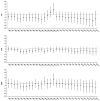Apparent temperature and cause-specific mortality in Copenhagen, Denmark: a case-crossover analysis
- PMID: 22016711
- PMCID: PMC3194112
- DOI: 10.3390/ijerph8093712
Apparent temperature and cause-specific mortality in Copenhagen, Denmark: a case-crossover analysis
Abstract
Temperature, a key climate change indicator, is expected to increase substantially in the Northern Hemisphere, with potentially grave implications for human health. This study is the first to investigate the association between the daily 3-hour maximum apparent temperature (Tapp(max)), and respiratory, cardiovascular and cerebrovascular mortality in Copenhagen (1999-2006) using a case-crossover design. Susceptibility was investigated for age, sex, socio-economic status and place of death. For an inter-quartile range (7 °C) increase in Tapp(max), an inverse association was found with cardiovascular mortality (-7% 95% CI -13%; -1%) and none with respiratory and cerebrovascular mortality. In the cold period all associations were inverse, although insignificant.
Keywords: cardiovascular; case-crossover; cerebrovascular; epidemiology; mortality; respiratory; temperature.
Figures
References
-
- Parry ML, Canziani OF, Palutikof JP, van der Linden PJ, Hanson CE, editors. Contribution of Working Group II to the Fourth Assessment Report of the Intergovernmental Panel on Climate Change, 2007. Cambridge University Press; Cambridge, UK and New York, NY, USA: 2007. [accessed on 17 August 2011]. Available online: http://www.ipcc-wg2.gov/publications/AR4/index.html.
-
- Kovats RS, Hajat S. Heat stress and public health: A critical review. Ann Rev Public Health. 2008;29:41–55. - PubMed
-
- Basu R, Samet JM. Relation between elevated ambient temperature and mortality: A review of the epidemiologic evidence. Epidemiol Rev. 2002;24:190–202. - PubMed
Publication types
MeSH terms
Substances
LinkOut - more resources
Full Text Sources


